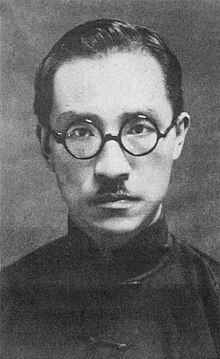Hu Xiansu | |
|---|---|
胡先骕 | |
 Hu in 1940 | |
| Born | 24 May 1894 |
| Died | 16 July 1968 (aged 74) |
| Resting place | Mount Lu, Jiangxi |
| Nationality | Chinese |
| Education | |
| Known for | Pioneer of botany and plant taxonomy in China |
| Children | 6 |
| Scientific career | |
| Fields | |
| Institutions | |
| Doctoral advisor | John George Jack |
| Notable students | |
| Author abbrev. (botany) | Hu |

Hu Xiansu or Hu Hsen-Hsu (simplified Chinese: 胡先骕; traditional Chinese: 胡先驌; Wade–Giles: Hu Hsien-Hsu, 24 May 1894 – 16 July 1968), courtesy name Buzeng (Chinese: 步曾), was a Chinese botanist, scholar, literary critic and educator. He was the founder of plant taxonomy in China and a pioneer of modern botany and paleobotany research in the country.[2] One of his most notable achievements as a botanist was the identification of the living fossil Metasequoia glyptostroboides (dawn redwood) in the 1940s, which was previously thought to have been extinct for over 150 million years.[2][3] This has been considered by some in the scientific community as one of the greatest botanical discoveries of the 20th century.[4]
Outside botany, Hu also made significant contributions in the field of literary critique and education. In 1922, in opposition of the New Culture Movement that promoted vernacular literature, Hu co-founded The Critical Review, a major Chinese-language journal which advocated the preservation of Chinese classical literature.[5][6] From 1940 to 1944, Hu served as the inaugural president of National Chung Cheng University, what is now primarily[a] Jiangxi Normal University. Targeted as an intellectual during the Cultural Revolution, Hu Xiansu endured repeated struggle sessions, the stress of which likely contributed to his fatal heart attack in Beijing on 16 July, 1968.[7]
- ^ Jiang 2016, p. 174.
- ^ a b Hu & Ma 2022.
- ^ LePage, Williams & Yang 2005.
- ^ Ma 2003.
- ^ Fung 2009, p. 777–813.
- ^ Sun 2023b.
- ^ Hu 2023, p. 53.
Cite error: There are <ref group=lower-alpha> tags or {{efn}} templates on this page, but the references will not show without a {{reflist|group=lower-alpha}} template or {{notelist}} template (see the help page).